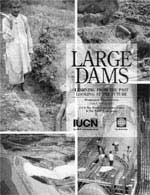Half truths
 constructive dialogue and objective assessments have always been a casualty in the conflicts and controversies that have surrounded large dams. Such projects have nevertheless played a major role in development efforts and in meeting a variety of ends like electricity generation. They have also been the key players in government-sponsored flood control and irrigation projects. In most cases, the World Bank (wb) has also drawn a lot of flak from conservationists and environmentalists alike, for funding such projects.
constructive dialogue and objective assessments have always been a casualty in the conflicts and controversies that have surrounded large dams. Such projects have nevertheless played a major role in development efforts and in meeting a variety of ends like electricity generation. They have also been the key players in government-sponsored flood control and irrigation projects. In most cases, the World Bank (wb) has also drawn a lot of flak from conservationists and environmentalists alike, for funding such projects.
In 1996, the wb 's operations evaluation department completed an internal review of 50 large dams funded by the bank. The International Union for Conservation of Nature and Natural Resources and the wb jointly hosted a two-day workshop in April 1997 to discuss the findings of the review and its implications for a more in-depth study. This book records the proceedings of the workshop. Divided into two parts, the first part of the book deals with the discussions and recommendations for future action. The second part deals with papers on the challenges facing the hydro-power industry, social issues like who are the beneficiaries of projects, and the sustainability of dams.
Presented in a dull monotone, the first part minutely details how the participants interacted with each other. Taking recourse to subtitles and boxes, the book summarises the papers presented by the participants and the events and conclusions of the conference. One of the notable achievements listed in the book is the agreement to establish a two-year world commission by November 1997, to assess the experience of existing large dam projects so as to improve practices and social and environmental conditions.
While the report acknowledges that dams have certain side-effects like relocation of people and a consequent degradation in their environment, it lays special emphasis on the function of dams in regulating the water regime of a river, power generation and flood control.
The report also indicates that resettlement should be made attractive for people to agree to move. Special emphasis should be laid on landless oustees who will be eager to move if compensated properly. People are usually coerced into moving from an area under a compensation scheme which does not give them a fair price for their land. They therefore end up subsidising the project.
Downstream impacts of dams normally do not get attention in the media, at least not the kind of attention that upstream impacts do. These impacts include the drying up of wells, impaired aquifer recharge, declining land productivity and declining fish yields.
The most serious effects are also rarely addressed. Among these include the loss of the annual deposition of silt and the stress of change upon the communities that are used to a cropping pattern based on annual flooding and have to switch to a cropping pattern based on rainfall.
The book, however, does not provide any concrete lessons for the future but comes up with mere excuses and suggestions on how to go ahead with building more dams. It is a well-argued case for going ahead with dams. Moreover, it is not possible in two days of deliberations to decide the future of the world. And the participants of the conference have attempted to do just that.
Related Content
- No time to lose, says Sunita Narain on the new IPCC report
- Al Gore's Statement on President Obama's Remarks on the Climate Crisis
- Budget 2013-2014: speech of P. Chidambaram, Minister of Finance
- CSE Press note: Who is the one not playing by the rules – India or the US?
- The census truth: More Indians have access to phones than to toilets
- BELLING THE BIG CAT (Editorial)
